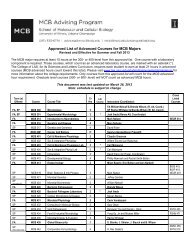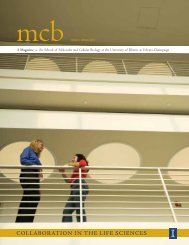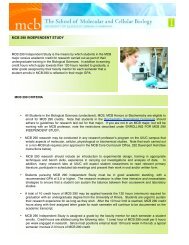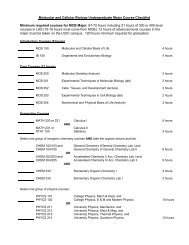- Page 1 and 2: I LSM 510 Laser Scanning Microscope
- Page 3 and 4: LSM 510 INTRODUCTION Developed in C
- Page 5 and 6: LSM 510 INTRODUCTION How to make be
- Page 7 and 8: LSM 510 INTRODUCTION Kodak XLS 8650
- Page 9 and 10: LSM 510 1 2 3 4 5 Notes on Device S
- Page 11 and 12: NOTES ON DEVICE SAFETY LSM 510 Cont
- Page 13 and 14: NOTES ON DEVICE SAFETY LSM 510 Gene
- Page 15 and 16: NOTES ON DEVICE SAFETY LSM 510 Note
- Page 17 and 18: NOTES ON DEVICE SAFETY LSM 510 Note
- Page 19 and 20: NOTES ON DEVICE SAFETY LSM 510 Warn
- Page 21 and 22: NOTES ON DEVICE SAFETY LSM 510 Warn
- Page 23 and 24: LSM 510 - SETUP REQUIREMENTS LSM 51
- Page 25 and 26: LSM 510 - SETUP REQUIREMENTS LSM 51
- Page 27 and 28: LSM 510 - SETUP REQUIREMENTS LSM 51
- Page 29 and 30: LSM 510 - SETUP REQUIREMENTS LSM 51
- Page 31 and 32: LSM 510 - SETUP REQUIREMENTS LSM 51
- Page 33 and 34: LSM 510 - SETUP REQUIREMENTS LSM 51
- Page 35 and 36: INTRODUCTION TO LASER SCANNING MICR
- Page 37: INTRODUCTION TO LASER SCANNING MICR
- Page 41 and 42: INTRODUCTION TO LASER SCANNING MICR
- Page 43 and 44: INTRODUCTION TO LASER SCANNING MICR
- Page 45 and 46: INTRODUCTION TO LASER SCANNING MICR
- Page 47 and 48: INTRODUCTION TO LASER SCANNING MICR
- Page 49 and 50: INTRODUCTION TO LASER SCANNING MICR
- Page 51 and 52: INTRODUCTION TO LASER SCANNING MICR
- Page 53 and 54: INTRODUCTION TO LASER SCANNING MICR
- Page 55 and 56: INTRODUCTION TO LASER SCANNING MICR
- Page 57 and 58: INTRODUCTION TO LASER SCANNING MICR
- Page 59 and 60: OPERATION LSM 510 Contents CHAPTER
- Page 61 and 62: OPERATION LSM 510 General / Softwar
- Page 63 and 64: OPERATION LSM 510 Software � WIND
- Page 65 and 66: OPERATION LSM 510 Quick start 4.3 Q
- Page 67 and 68: OPERATION LSM 510 Quick start 4.3.3
- Page 69 and 70: OPERATION LSM 510 Quick start Fig.
- Page 71 and 72: OPERATION LSM 510 Quick start (2) C
- Page 73 and 74: OPERATION LSM 510 Quick start (3) C
- Page 75 and 76: OPERATION LSM 510 Quick start (12)
- Page 77 and 78: OPERATION LSM 510 Quick start 4.3.7
- Page 79 and 80: OPERATION LSM 510 Quick start (8) C
- Page 81 and 82: OPERATION LSM 510 Overview of Menu
- Page 83 and 84: OPERATION LSM 510 Overview of Menu
- Page 85 and 86: OPERATION LSM 510 Image Acquisition
- Page 87 and 88: OPERATION LSM 510 Image Acquisition
- Page 89 and 90:
OPERATION LSM 510 Image Acquisition
- Page 91 and 92:
OPERATION LSM 510 Image Acquisition
- Page 93 and 94:
OPERATION LSM 510 Image Acquisition
- Page 95 and 96:
OPERATION LSM 510 Image Acquisition
- Page 97 and 98:
OPERATION LSM 510 Image Acquisition
- Page 99 and 100:
OPERATION LSM 510 Image Acquisition
- Page 101 and 102:
OPERATION LSM 510 Image Acquisition
- Page 103 and 104:
OPERATION LSM 510 Image Acquisition
- Page 105 and 106:
OPERATION LSM 510 Image Acquisition
- Page 107 and 108:
OPERATION LSM 510 Image Acquisition
- Page 109 and 110:
OPERATION LSM 510 Image Acquisition
- Page 111 and 112:
OPERATION LSM 510 Image Acquisition
- Page 113 and 114:
OPERATION LSM 510 Image Acquisition
- Page 115 and 116:
OPERATION LSM 510 Image Acquisition
- Page 117 and 118:
OPERATION LSM 510 Image Acquisition
- Page 119 and 120:
OPERATION LSM 510 Image Acquisition
- Page 121 and 122:
OPERATION LSM 510 Image Acquisition
- Page 123 and 124:
OPERATION LSM 510 Image Acquisition
- Page 125 and 126:
OPERATION LSM 510 Image Acquisition
- Page 127 and 128:
OPERATION LSM 510 Image Acquisition
- Page 129 and 130:
OPERATION LSM 510 Routine Mode 4.6
- Page 131 and 132:
OPERATION LSM 510 Routine Mode 4.6.
- Page 133 and 134:
OPERATION LSM 510 Routine Mode 4.6.
- Page 135 and 136:
OPERATION LSM 510 Routine Mode �
- Page 137 and 138:
OPERATION LSM 510 Routine Mode �
- Page 139 and 140:
OPERATION LSM 510 Image Optimizatio
- Page 141 and 142:
OPERATION LSM 510 Image Optimizatio
- Page 143 and 144:
OPERATION LSM 510 Image Optimizatio
- Page 145 and 146:
OPERATION LSM 510 Image Optimizatio
- Page 147 and 148:
OPERATION LSM 510 Image Optimizatio
- Page 149 and 150:
OPERATION LSM 510 Image Optimizatio
- Page 151 and 152:
OPERATION LSM 510 Image Optimizatio
- Page 153 and 154:
OPERATION LSM 510 Image Optimizatio
- Page 155 and 156:
OPERATION LSM 510 Image Optimizatio
- Page 157 and 158:
OPERATION LSM 510 Image Optimizatio
- Page 159 and 160:
OPERATION LSM 510 Analysis of Image
- Page 161 and 162:
OPERATION LSM 510 Analysis of Image
- Page 163 and 164:
OPERATION LSM 510 Analysis of Image
- Page 165 and 166:
OPERATION LSM 510 Analysis of Image
- Page 167 and 168:
OPERATION LSM 510 Analysis of Image
- Page 169 and 170:
OPERATION LSM 510 Analysis of Image
- Page 171 and 172:
OPERATION LSM 510 Analysis of Image
- Page 173 and 174:
OPERATION LSM 510 Analysis of Image
- Page 175 and 176:
OPERATION LSM 510 Analysis of Image
- Page 177 and 178:
OPERATION LSM 510 Analysis of Image
- Page 179 and 180:
OPERATION LSM 510 Analysis of Image
- Page 181 and 182:
OPERATION LSM 510 Analysis of Image
- Page 183 and 184:
OPERATION LSM 510 Analysis of Image
- Page 185 and 186:
OPERATION LSM 510 Analysis of Image
- Page 187 and 188:
OPERATION LSM 510 Analysis of Image
- Page 189 and 190:
OPERATION LSM 510 Analysis of Image
- Page 191 and 192:
OPERATION LSM 510 Analysis of Image
- Page 193 and 194:
OPERATION LSM 510 Analysis of Image
- Page 195 and 196:
OPERATION LSM 510 Analysis of Image
- Page 197 and 198:
OPERATION LSM 510 Database / Loadin
- Page 199 and 200:
OPERATION LSM 510 Database / Loadin
- Page 201 and 202:
OPERATION LSM 510 Database / Loadin
- Page 203 and 204:
OPERATION LSM 510 Database / Loadin
- Page 205 and 206:
OPERATION LSM 510 Database / Loadin
- Page 207 and 208:
OPERATION LSM 510 Database / Loadin
- Page 209 and 210:
OPERATION LSM 510 Macro 4.10 Macro
- Page 211 and 212:
OPERATION LSM 510 Macro 4.10.3 Reco
- Page 213 and 214:
OPERATION LSM 510 Macro 4.10.5 Edit
- Page 215 and 216:
OPERATION LSM 510 Shut-Down Procedu
- Page 217 and 218:
OPERATION LSM 510 Shut-Down Procedu
- Page 219 and 220:
OPERATION LSM 510 Annex Application
- Page 221 and 222:
OPERATION LSM 510 Annex Application
- Page 223 and 224:
OPERATION LSM 510 Annex Application
- Page 225 and 226:
OPERATION LSM 510 Annex Application
- Page 227 and 228:
OPERATION LSM 510 Annex Application
- Page 229 and 230:
OPERATION LSM 510 Annex 4.12.2 Filt
- Page 231 and 232:
OPERATION LSM 510 Annex Fig. 4-171
- Page 233 and 234:
OPERATION LSM 510 Annex 4.12.4.3 Op
- Page 235 and 236:
OPERATION LSM 510 Annex � Clickin
- Page 237 and 238:
OPERATION LSM 510 Annex 4.12.5 Scan
- Page 239 and 240:
OPERATION LSM 510 Annex Moves �
- Page 241 and 242:
OPERATION LSM 510 Annex The Current
- Page 243 and 244:
OPERATION LSM 510 Annex 4.12.6 Spec
- Page 245 and 246:
OPERATION LSM 510 Annex Pin assignm
- Page 247 and 248:
OPERATION LSM 510 Annex � Change
- Page 249 and 250:
OPERATION LSM 510 Annex To use the
- Page 251 and 252:
OPERATION LSM 510 Annex The single
- Page 253 and 254:
OPERATION LSM 510 Annex Gain and of
- Page 255 and 256:
INTRODUCTION TO LASER SCANNING MICR
- Page 257 and 258:
INTRODUCTION TO LASER SCANNING MICR
- Page 259 and 260:
INTRODUCTION TO LASER SCANNING MICR
- Page 261 and 262:
INTRODUCTION TO LASER SCANNING MICR
- Page 263 and 264:
INTRODUCTION TO LASER SCANNING MICR
- Page 265 and 266:
INTRODUCTION TO LASER SCANNING MICR
- Page 267 and 268:
INTRODUCTION TO LASER SCANNING MICR
- Page 269 and 270:
INTRODUCTION TO LASER SCANNING MICR
- Page 271 and 272:
INTRODUCTION TO LASER SCANNING MICR
- Page 273 and 274:
INTRODUCTION TO LASER SCANNING MICR
- Page 275 and 276:
INTRODUCTION TO LASER SCANNING MICR
- Page 277 and 278:
INTRODUCTION TO LASER SCANNING MICR
- Page 279 and 280:
INTRODUCTION TO LASER SCANNING MICR
- Page 281 and 282:
INTRODUCTION TO LASER SCANNING MICR
- Page 283 and 284:
INTRODUCTION TO LASER SCANNING MICR
- Page 285 and 286:
INTRODUCTION TO LASER SCANNING MICR
- Page 287 and 288:
INTRODUCTION TO LASER SCANNING MICR
- Page 289 and 290:
INTRODUCTION TO LASER SCANNING MICR
- Page 291 and 292:
INTRODUCTION TO LASER SCANNING MICR
- Page 293 and 294:
INTRODUCTION TO LASER SCANNING MICR
- Page 295 and 296:
INTRODUCTION TO LASER SCANNING MICR
- Page 297 and 298:
INTRODUCTION TO LASER SCANNING MICR
- Page 299 and 300:
INTRODUCTION TO LASER SCANNING MICR
- Page 301 and 302:
INTRODUCTION TO LASER SCANNING MICR
- Page 303 and 304:
INTRODUCTION TO LASER SCANNING MICR
- Page 305 and 306:
INTRODUCTION TO LASER SCANNING MICR
- Page 307 and 308:
INTRODUCTION TO LASER SCANNING MICR
- Page 309 and 310:
INTRODUCTION TO LASER SCANNING MICR
- Page 311 and 312:
INTRODUCTION TO LASER SCANNING MICR
- Page 313 and 314:
INTRODUCTION TO LASER SCANNING MICR
- Page 315 and 316:
INTRODUCTION TO LASER SCANNING MICR
- Page 317 and 318:
INTRODUCTION TO LASER SCANNING MICR
- Page 319 and 320:
INTRODUCTION TO LASER SCANNING MICR
- Page 321 and 322:
INTRODUCTION TO LASER SCANNING MICR
- Page 323 and 324:
INTRODUCTION TO LASER SCANNING MICR
- Page 325 and 326:
INTRODUCTION TO LASER SCANNING MICR
- Page 327 and 328:
INTRODUCTION TO LASER SCANNING MICR
- Page 329 and 330:
INTRODUCTION TO LASER SCANNING MICR
















